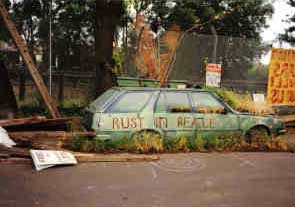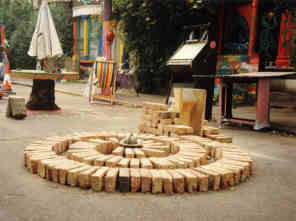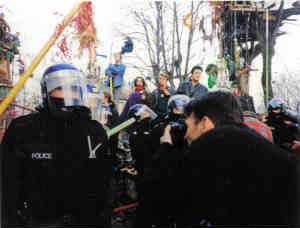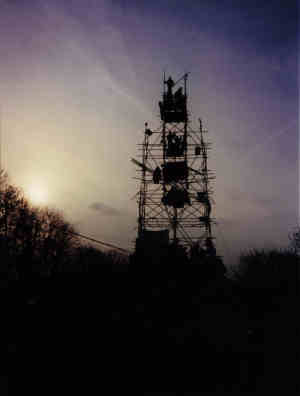Claremont Road and the M11 Link Road

I was walking back from the swimming pool on a Monday morning in the summer of 1994 when I noticed that Claremont Road had been brightly painted and decorated. I turned into Claremont Road from Cathall Road and was astonished by the colourful decoration of the houses, the amusing street sculptures and the clever use of abandoned cars. I returned later and took a series of photographs, and am very glad that I did..
Claremont Road was in the way of the M11 Link Road. Some form of road through the area has been proposed since World War 11, and now the Department of Transport wanted to build a six lane dual carriageway through Leyton and Leytonstone. This resulted in the vibrant and popular 'No M11 Link Road' campaign. I had been involved since 1992 as part of Open University Social Sciences studies, and completed an OU project in 1994. There were many protests along the route of the Link Road, especially when houses were demolished and their inhabitants forcibly removed. Claremont Road was only one of the streets at risk.

The DOT acquired properties under Compulsory Purchase Orders and once empty they were either demolished or made uninhabitable by the destruction of kitchens, bathrooms and staircases. However, in Claremont Road and elsewhere, people moved into the properties before this happened. The road became well known for the decorations, the street parties, the café, the 'art house', music, theatre and there was even a ghost house. It was something to show to visitors. Because of the street sculptures, no vehicle could be driven along Claremont Road. Opposite the terrace of Victorian houses was the Central Line. It was quiet and a safe place for children to play.

Things could not last, and despite many hopes, petitions and protests, on Monday November 28th, 1994, the riot squad eventually arrived to evacuate Claremont Road. The atmosphere was electric, all morning we had been awaiting the police and several times we were told they were on their way. I was relieved to see a cat and her four kittens safely taken away from the café. At about 11.00 there was a ripple and then a roar of laughter. It was the postman.

Back into Claremont Road. I was half way along the terrace and saw that the police, in full riot gear, were entering from both ends. The noise of the demonstrators was deafening, with whistles, shouts and music. I stood quietly, silent amidst this cacophony, but took photographs. I did not notice that the Central Line had been suspended. The police started carrying people out; four of them took each of my limbs as I politely told them of the wrongs of the situation. I was dumped, fairly gently, in Grove Green Road, with my camera unharmed.

It was Wednesday before Claremont Road was cleared of protestors, as many people had barricaded themselves in the houses, under the houses and on the roofs. But eventually, when the last person had been evicted, the bulldozers came in and Claremont Road was no more.
Houses and flats were demolished; the DOT's figure is 263, with 550 people displaced. The No M11 Link Road Campaign estimated that 500 dwelling units were demolished 1,000 people lost their homes.
It was not tunnelled following the 1983 Pubic Inquiry because of the cost - which rose from £200 million in June 1993 to £360 million in June 1999 (DOT figures).
Maureen Measure
This page last updated 14th May 2006.
 The local history society for the Leyton & Leytonstone area of East London
The local history society for the Leyton & Leytonstone area of East London





